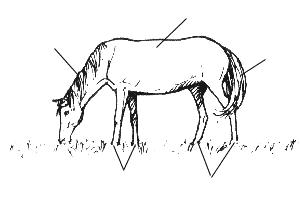The author of the “Stroyhak” channel posted several clever tricks for home craftsmen in his video.
1. If you are the lucky owner of a mechanical tape measure, masking tape will come to your aid. Stick it on the tape measure and you won't have to constantly run to the table to write down the results. All this can be done directly on the roulette wheel. And only then transfer it to paper. Or just stick the tape itself.
Tricky tape
2. To keep the spatula clean, for example, when working with some dirty chemicals that are then difficult to tear off from the tool, use durable household tape. This is a very handy little trick. Strong and at the same time easily torn across. Stick it on the spatula and it will always remain clean after work. The utility tape is removed without leaving any traces. This technique is very useful when working with bitumen mastic, for which the spatula has to be washed with a solvent. By the way, clients perfectly seal the noses of construction tubes; there is no need to tighten various screws. It’s just better to glue it with an offset edge. This makes it easier to shoot later.
Cellophane helps
3. Often pva glue dries on the threads of the bottles in which it is located. Unscrewing the lid next time is very difficult. To prevent this from happening again, take a thick polyethylene bag and cut out a small piece from it. The thread is now safe. And the bottle of glue will always be easy to open.

Circular saw attachment
4. The circular saw has several attachments of different diameters. But they all periodically have one problem: when drilling a hole, a wooden circle remains, wedged inside the saw, and it can be very difficult to get it out of there. Of course, you can use a screwdriver, but it is more convenient to use a screw and screw it into a piece of wood. And he, resting against the base of the saw, will complete the problematic remainder. Useful trick For home handyman.

Plastic pipe clamp
5. If you have a piece left plastic pipe from repair, it will make an excellent clamp for various wires and cords. Cut off a few centimeters with any tool. Use a hacksaw or special drill to drill 2 through holes. It is convenient to make drills with a small diameter first, and then a slightly larger one. For example, a master has a drill with a diameter of 5 mm. The edges of the cut part can be sharpened sandpaper. We take an elastic band, pull it through the hole and tie knots at the ends. The device is ready. A bunch of old unruly wires will now be in order.

A trick for easy drilling
6. Masking tape will be useful to us in one more case. When you need to make holes on the wall for some gadget. For example for a telephone. Paste it on the device and with a simple pencil we show seat for fastening. Remove the tape and mark the places for drilling. Now all that remains is to glue it to the wall. And it can be corrected. Now let's make the holes.

Let's work smarter
7. If you have adjustable or, as they are also called, adjustable ones, use the following advice. Cut a couple of pieces from the rubber or silicone hose and place them on the jaws of the tool. Now you won't leave any scratches when working on delicate surfaces like chrome parts. To avoid losing pieces of the hose, you can put them on the tool after first removing the plastic handles.

Visualization of tricks on video
Watch the video to see how to use tricks and tricks for a smart home craftsman.
Jars will help you store things not only on the shelf, but also under it. IN glass jars It is very convenient to store nails, fasteners and other small parts. To prevent the jars from “dangling under your feet,” they can be secured above your head - just drill a couple of holes in the lid and screw it to the shelf with self-tapping screws. To store, simply screw the jar into the lid. Good big lids are usually used to seal jam jars.

Thanks to the hooks, your keys won't get lost in the drawer. Every home has drawer, full of rattling keys that are rarely used, but cannot be thrown away. To prevent your keys from rattling or rolling under other things, you can hang them on hooks - right inside the box.

Dish drying will organize your tools. We found this recipe on YouTube. It turns out that dish dryers seem to be specially created for storing wrenches. They also come in almost any size and shape and, if necessary, bend quite well. Therefore, a dish dryer can be selected for any garage box.
Magnetism vs chaos
Determine the type of metal under the paint. .To drill through steel, you must use drilling paste. In the case of aluminum, you can do without paste. How to determine what kind of metal is hidden under a layer of paint? “Winged” metal is indifferent to magnets, while steel is attracted to them.
Don't lose small details. Small screws, nuts and washers tend to roll away into places where you can never reach them again. It’s easier to store them next to a magnet, which will easily tame their ardor. By the way, using a magnet you can conveniently carry small fasteners in your pockets.
Calm down the oiler dancing at the machine. Vibrations from the engine of a machine or tool can gradually and imperceptibly push light oil cans and cans that may need to be kept handy off the table. To prevent containers from “dancing” on metal surfaces, attach a magnet with a soft rubber pad to their bottom.
The trash bag saves water. A simple trick will help you carry a bucket of water without losing a drop. Place a large trash bag in the bucket and pour the liquid directly into it. Then tie the bag in a knot and run home, boldly swinging the bucket.
The jack defeats rust. Dismantle external unit If the air conditioner is rusted to the supports, a jack will help. It can be rested against the nearest wall, window sill, or directly into the ground if the block is hung low. As a rule, it is enough to make only a couple of turns.

A bolt and nut repair a chain. A bolt and nut of a suitable diameter are quite capable of quickly and reliably repairing a broken chain. The main thing is not to forget to remove the broken ring before this: once open, it bends easily, turning into a real “weak link”.
 Left is right, right is wrong
Left is right, right is wrong
Adjustable wrench for dummies. This one is amazing convenient tool The only drawback is the ability to unexpectedly slip off a nut or bolt head. This happens due to improper use. There are two simple rules: firstly, pull the key rather than push it - this way your hands will be safer. Secondly, the main force should fall on the stationary jaw - a movable jaw under heavy load can “release” the nut. So, hold the key with the movable sponge towards you and pull it towards you.
 Water pipes is not visible until they leak, says popular wisdom. To communicate with plumbers, use our short illustrated dictionary.
Water pipes is not visible until they leak, says popular wisdom. To communicate with plumbers, use our short illustrated dictionary.
Food coloring will indicate a problem with the plumbing. Condensation or dew on pipes is often mistaken for a leak. If you have your own boiler in your home, then the diagnosis is very easy to make. Add some food coloring to the boiler and see if your “dew” gets colored.

A tennis ball will bring the blanket to life. Blankets and sleeping bags become less warm over time. This is due to the fact that the air cavities that provide thermal insulation properties are crushed and reduced. By placing the blanket in the dryer along with a tennis ball or two, you'll give it a good fluffing and re-airing.

What is a stapler? Not all office workers know the answer to this question. Meanwhile, this report stapling device is also perfect for storing hacksaw blades. This method will help protect your hands from cuts and the blades from becoming dull.
This article, as usual, has a beginning, but by definition it cannot have an end. Advice for the home handyman is a truly inexhaustible topic. Small, simple tips home craftsmen often need more than detailed articles on one topic. I will try to constantly update the material if I have free time and desire, of course.
1. How to drive a nail into the edge of a board
To drive a nail into the edge of the board without splitting it, it is enough to first tap the edge of the board from above with a hammer. If the nail is thin, then you can drive it in immediately after this - the board will not split. If the nail is thick enough, then you need to first fill the hole with a thin nail, and then drive in the thick one.
2. How to carefully pour paint
To avoid staining the outside of the paint when pouring paint from one can to another, you need to place the empty can inside a plastic bag, and wrap the edges of the bag inside the can. After the liquid has been poured, the bag is torn from the bottom, removed from the jar and thrown away. The jar remains clean.
3. How to hang a painting or photo evenly on the wall
To hang a picture evenly on the wall, it is advisable to have a level. If you don’t have a level at hand, you can make one at home from an empty transparent plastic bottle: Fill it about halfway with water - now, no matter how you turn the bottle, the surface of the water will always be horizontal.
In order to hang a large item on the wall - for example, a carpet - you can make a more serious water level. To do this, we take two medical syringes and a rubber or PVC tube of the required length. We connect the syringes together with a tube and fill the system with water. The water in the syringes will always be at the same level.
4. How to screw a screw into plastic
To securely screw a screw or bolt into plastic, a home craftsman first drills a hole in the part that is smaller than the diameter of the thread. Then the screw is heated well with a soldering iron or on the stove (for small detail A lighter flame is enough). The screw will easily screw into the part and, melting the plastic, forms a good thread.
5. How to cut plastic
It can be quite difficult to cut thermoplastic plastic with a hacksaw or a jigsaw, since the plastic melts and the blade jams. Apply a little machine oil along the cut line and things will go faster.
6. How to make drop-down pliers
The DIYer often has to work alone, and when working, it can be difficult to open the pliers with one hand. Connect the handles of the pliers with a piece of elastic rubber hose of a suitable diameter, and the pliers will open on their own.
7. How to collect iron filings
The easiest way to collect iron filings or small shavings is, of course, with a magnet. It is difficult to clean the magnet itself from sawdust later. Advice: insert a magnet into the plastic bag, which after finishing work, turn it inside out - and the magnet will remain clean, and the sawdust will remain in the bag.
8. How not to lose a spring
When disassembling or assembling, springs have a nasty property: they jump out of your hands, fly away and get lost. A simple tip for the home craftsman: before starting the process, tie a thread to one of the coils of the spring - now it won’t go anywhere.
9. How to bend duralumin
In order not to break the fragile duralumin when bending, I advise you to heat the bend area gas burner and then lubricate laundry soap. Continue heating the bend until the soap layer completely turns black - this will be the temperature of maximum plasticity of duralumin.
10. How to increase the temperature of the soldering iron
If the temperature of your soldering iron tip is not enough, then I advise you to wrap the body of the soldering iron in a couple of layers aluminum foil. By reducing heat loss, you will thereby increase the temperature of the tip.
11. How to remove an old screw
Unscrewing an old screw from a hard board can be problematic: the slots come off. Clamp the blade of the screwdriver with an adjustable wrench and insert the tip into the slots of the screw. Press down on the screwdriver with one hand, and slowly turn the key with the other - the screw will come out like a cute little thing.
The task can be further facilitated by heating the screw - pressing the soldering iron tip to its head.
12. How to cut plywood
The edges of plywood often chip when sawing. To keep the edges even and smooth, wet the plywood with water along the cut line.
13. How to sharpen a tool
A cutting tool is sharpened faster and easier if you soak it in a salt solution for half an hour beforehand and moisten the sharpening stone with kerosene.
14. How to clean copper filings from a file
Move a powerful, well-heated and tinned soldering iron along the notch of the file - the sawdust will gather into large lumps that can be easily removed.
15. How to saw thin metal
To accurately saw a thin piece of metal, clamp it in a vise between two flat pieces of wood and saw through the entire “sandwich.”
16. How to restore an old file
To restore an oily, rusty, worn file, dip it in a sulfuric acid solution for a few minutes and then rinse thoroughly with a soda solution.
17. How to drill a vertical hole
Place a small mirror on the workpiece close to the drilling point. The tool drill and its reflection in the mirror should form one straight line.
18. How to cut round timber to length
To cut a round stick evenly along the entire length, you can make a template from a metal tube of a suitable cross-section with a cut in the middle. First, make a cut without a template, and when the saw is deep enough, put a template on top and saw the part to the end.
19. How to upgrade a shovel
If you drill a dozen holes in a shovel with a diameter of about 20 millimeters, then wet soil and clay will stick to it less.
20. How to cut rubber smoothly
Lubricate the knife blade with laundry soap and cutting rubber will be much easier, and the edges will be smoother.
21. How to tighten a screw in a hard-to-reach place
Stretch a piece of rubber tube over the tip of the screwdriver and insert a screw or screw into its end.
22. How to remove a broken key from a lock
Insert a jigsaw file into the lock cylinder parallel to the key fragment, then turn the file with its teeth towards the fragment and pull it out.
23. How to protect your hands from calluses
When working with an axe, sledgehammer, shovel and other tools, put foam rubber rings on your palms - and it will be convenient to work and will protect you from calluses.
Wrapping your tool handles in vinyl tape will also help you get rid of calluses to a large extent.
24. How to collect small glass fragments
Make a sausage from a piece of plasticine and roll it over the place where the glass was broken. This way you will collect everything, even the smallest fragments.
25. How to extend the life of wooden tool handles
Before putting the instrument on wooden handles, boil the handles in drying oil - this will protect them from cracking.
26. How to fit a chisel and chisel tightly onto the handle
Pour a mixture of rosin and ash or sand into the hole in the handle, heat the spur of the tool red-hot and quickly insert it into the hole. The tool will be securely fastened in the handle.
27. How to hammer a nail into plaster
To prevent the plaster from crumbling, stick a piece of masking tape over the place where you want to drive the nail.
28. How to hammer a nail into hard wood
Before driving a nail into hard rock wood, lubricate the nail with soap or paraffin, and things will go much easier.
29. How to solder a massive part
If the power of the soldering iron is not enough to solder the part, place the part on the sole of a hot iron.
30. How to preserve cement
Cement in paper bags is not stored for a long time and quickly loses its properties. You can preserve it for several years by packing it together with paper packaging in a plastic bag and tying it as tightly as possible.
31. How to find a deeply driven nail
Finding a deeply driven and puttied nail - for example, in floorboards - can sometimes be difficult. Magnetize the needle and move it on a thread along the board at a height of approximately 1 millimeter. It will bend over the nail and accurately indicate the place.
32. How to drill a small hole in glass
Use sandpaper to sharpen a flat file like a sharp chisel. Secure in the chuck hand drill and drill slowly, periodically cooling and sharpening. In about 15 minutes you will drill through glass 6 millimeters thick.
33. How to cut a thin-walled pipe
Place two blades in a hacksaw with the teeth facing each other. The cutting forces will become equal in both directions.
34. How to find a crack in metal
If you cannot find a crack in a metal part, paint over its surface with chalk solution and dry it. Then add a drop of kerosene to the search area. The crack will immediately appear.
35. How to securely fix the nut
If you don’t have a spring washer at hand, you can securely fix the nut from unwinding by first wrapping the bolt with plastic film.
36. How to protect your hands when working with solvents
Before putting on gloves for handling caustic liquids, lubricate your hands with a rich cream and sprinkle with talcum powder or baby powder. Now there will be no burn, even if the glove breaks.
37. How to find holes in the wall after wallpapering
To find the places where the screws you need were previously screwed in after wallpapering, insert broken pieces of matches into the holes in the wall, leaving “stumps” 1.5-2 millimeters high on the surface. They will not interfere with the wallpaper, but you will find the holes later without any problems.
Today we will tell you how to make five useful ones with your own hands. homemade instruments for home.
Hi all! In this episode I will show you several interesting ideas some of which you might like.
If you need to cut straight plastic or metal pipe, then the following tool will help you.  Take a metric tape from a tape measure, cut 40-50 cm, evenly folding the ends together, drill two holes and tighten with small screws.
Take a metric tape from a tape measure, cut 40-50 cm, evenly folding the ends together, drill two holes and tighten with small screws.  Now you can easily draw a line along which you will make a perfectly even cut.
Now you can easily draw a line along which you will make a perfectly even cut. 
 If on time in hard to reach place If you struggle with an open-end wrench, you lose a lot of time or patience, and if you can’t get it with a ratchet, you’ll probably need a screwdriver with a universal joint.
If on time in hard to reach place If you struggle with an open-end wrench, you lose a lot of time or patience, and if you can’t get it with a ratchet, you’ll probably need a screwdriver with a universal joint.
To do this, we need an adapter for screwdriver heads with interchangeable attachments.  Using sandpaper or a grinder, we grind off the nozzle and screwdriver on both sides, and cut off about 2.5 centimeters from a bolt of suitable size. There are two holes at both ends, we make two cuts at 90 degrees relative to each other. All we have to do is drill holes in the screwdriver with the adapter and pin them.
Using sandpaper or a grinder, we grind off the nozzle and screwdriver on both sides, and cut off about 2.5 centimeters from a bolt of suitable size. There are two holes at both ends, we make two cuts at 90 degrees relative to each other. All we have to do is drill holes in the screwdriver with the adapter and pin them.  Now, when unscrewing a bolt or nut in a difficult place, you will not lose liters of sweat for every millimeter passed with an open-end wrench))
Now, when unscrewing a bolt or nut in a difficult place, you will not lose liters of sweat for every millimeter passed with an open-end wrench))  Do you need to pour liquid into a container with a small neck? In this case, you can make a small funnel from the fuel filter. You just need to cut off the outlet part of the filter and the funnel is ready.
Do you need to pour liquid into a container with a small neck? In this case, you can make a small funnel from the fuel filter. You just need to cut off the outlet part of the filter and the funnel is ready.  You may have noticed inconveniences when changing the drill chuck, namely the teeth of the key slipping. You can upgrade it with a thick blade screwdriver.
You may have noticed inconveniences when changing the drill chuck, namely the teeth of the key slipping. You can upgrade it with a thick blade screwdriver.  Having made a slot in the screwdriver shaft and sharpened the key shaft, we insert it into the slot, and after drilling a hole, tighten it with a screw.
Having made a slot in the screwdriver shaft and sharpened the key shaft, we insert it into the slot, and after drilling a hole, tighten it with a screw.  Now you don’t have to worry about the chuck’s teeth breaking off when you change drills in a hurry, and now, thanks to the bright handle, finding the key among the heap will be easier.
Now you don’t have to worry about the chuck’s teeth breaking off when you change drills in a hurry, and now, thanks to the bright handle, finding the key among the heap will be easier.  If you need to draw a circle large diameter, and you don’t have a large compass, then you need to make holes on the carpenter’s square every centimeter.
If you need to draw a circle large diameter, and you don’t have a large compass, then you need to make holes on the carpenter’s square every centimeter.  Now, having installed a drill or nail at the zero mark, you can draw a circle of the diameter we need.
Now, having installed a drill or nail at the zero mark, you can draw a circle of the diameter we need.  And also, after this modification, it became easier to draw longitudinal lines.
And also, after this modification, it became easier to draw longitudinal lines.  Perhaps the reader did not understand something, in which case you can watch the video.
Perhaps the reader did not understand something, in which case you can watch the video.
Our useful tips, even if they are often called life hacks, undoubtedly help site visitors solve any problems they may have. Sometimes the proposed solutions may even seem primitive, but for some reason they themselves do not come to mind. After reading them, you wonder how you yourself couldn’t come up with such a simple and very effective technique to solve the difficult situation that arose.
Today we offer you another portion of very simple recommendations, which you can mark for yourself and take into account.
Have you ever thought about what this simple tool, like a brush, does it have its own operating principle? It consists of storing a small supply of paint and then distributing it evenly over the surface to be painted.
In order for the brush to cope with its task properly, it must be cleaned and thoroughly dried after use. However, even in this case, there remains a fairly large number of villi stuck together. For this reason, the brush will be unable to hold required amount paints. To solve this problem and unstick the stuck together fibers, you just need to carefully comb the brush with a regular comb.
All home DIYers know very well that masking tape is simply a great thing. With its help you can do many simple and very useful things, about which, for example,. This tape is also useful for its intended purpose: it is able to form a clear boundary between the areas to be painted and not to be painted, and to protect them from accidental touches of the brush.
However, even this convenient thing, like masking tape, can cause problems for insufficient experienced craftsman. If you start removing the tape after the applied paint layer has completely dried, there is a high risk of fragments of this layer breaking along with it. To avoid this phenomenon, you can use one of the following methods:
- remove the tape before the paint dries completely;
- Carefully trim the paint layer where it meets the masking tape.
Useful tips for those involved in renovation and carpentry work
Useful tips can help you use tools correctly or make them easier to use. A striking example of this is our recommendation for using such a simple device as a screwdriver.
As a rule, to tighten screws, screws and self-tapping screws, we use working hand, rotating it and constantly intercepting the screwdriver handle. You'll spend significantly less effort if you do things differently. It is much more convenient to press the screwdriver firmly against the screw with your working hand, and with the other hand make rotational movements, as shown in the following video:
We hope that the text on French in this video, a French screwdriver and very french hand didn’t confuse you, and you were able to grasp the essence of the life hack we proposed :).
But this situation is familiar to many inexperienced masters:
You can avoid it if you dull the nail before driving it, trying, for example, to hammer it into something metal
That's all the useful tips we have prepared for you today. But the point we have made should rather be considered an ellipsis, since we intend to continue to feed you with easy and very necessary information.








